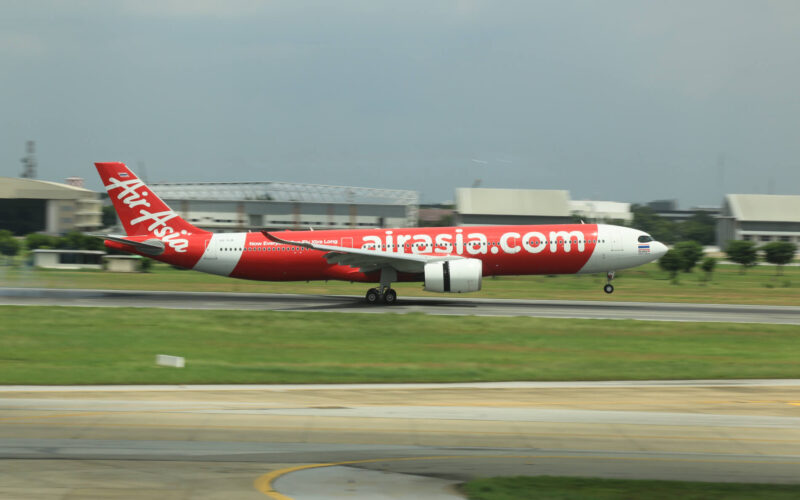With almost 1,500 deliveries of the A330ceo, there is little doubt that the aircraft program was a success for Airbus. The A330neo, launched in 2014, was set to follow the success of its predecessor – yet it has struggled. The order book, standing at 332 aircraft, is far off the 1,000 units that Airbus predicted to sell.
And it might shrink faster, as one of the main customers of the program – AirAsia X – is struggling.
Struggles in Asia
AirAsia X is an AirAsia group airline focused on providing low-cost long-haul services with its fleet of all-wide-body aircraft. The airline has seen relative success, as its profits went up, down into a loss, and up again. Nonetheless, the most recent trend was only downwards, which has put AirAsia X into a very fragile situation.
In 2018 and 2019, AirAsia X posted a net loss of MYR400 million ($98.4 million) and MYR520 million ($128 million), respectively. The COVID-19 pandemic brought up another challenge for the already limping carrier. Asia-Pacific, arguably, has been the most restricted travel space in the world, as governments were wary to repeat the scenario of the SARS outbreak in the early-2000s.
Thus, AirAsia X barely limped on throughout the year. The airline, which carried 6 million passengers throughout the previous year, flew only 1.1 million as of June 30, 2020. Q3 2020 results have not provided a sign of improvement and AirAsia X, at the end of the quarter, has logged an MYR1.1 billion ($270.8 million) year-to-date loss ‒ the highest in its history. As Q4 2020 has rolled around the corner, there are barely any signs that showcase that AirAsia X’s situation has improved.
AirAsia X restructuring
The writing was on the wall – AirAsia X had to do something regarding its situation if it were to survive.
“An imminent default of contractual commitments will precipitate a potential liquidation of the airline,” read the carrier’s press release dated October 6, 2020, when AirAsia X announced that it has entered a restructuring process.
The company indicated that a “major debt restructuring and a renegotiation of its financial obligations,” including aircraft acquisitions, or as the airline put it “aircraft fleet right-sizing”, would be required in order for the company to move forward.
After all, the company shareholders’ equity dwindled down to a minus MYR1.1 billion ($270.8 million) as of September 30, 2020. During the same period last year, it was equal to MYR137 million ($33.7 million). While previously the company could repay its debts and still have $33.7 million left, the situation has only gotten worse.
The restructuring plan itself has AirAsia X creditors ringing alarm bells. In October 2020, the company planned to restructure its debt by proposing debt settlements and waivers of debt that involve unsecured creditors “to arrive at a debt structure that is sustainable from future operating cash flows.”
Airbus is one of the creditors ringing those bells, as the aircraft manufacturer is at risk of losing as much as MYR48.71 billion ($12 billion) of the cash that AirAsia X owes it. The sum includes pre-delivery payments for aircraft orders and future debt calculation for aircraft purchases, according to Kuala Lumpur High Court documents seen by Reuters. According to the filing, Airbus holds about 75% of AirAsia X’s total debt, making it one of the worst-hit creditors if the Malaysian low-cost long-haul airline fails or restructures its debt significantly.
For Airbus, the crumbling AirAsia X poses another problem. While aircraft delivery deferrals are nothing out of the norm in this day and age due to the current downturn, the A330neo is particularly exposed to AirAsia X’s troubles.
“The right aircraft for us”
Despite a bumpy start to the relationship, including public threats of cancelling its orders from Tony Fernandes, the chief executive officer of AirAsia group, the Malaysian company was happy with the A330neo.
“We have looked at every aspect of the A330neo from technical performance and reliability to passenger comfort and it is clearly the right aircraft for us to expand efficiently our fast-growing long haul network,” Fernandes stated in July 2018, as AirAsia X added 34 Airbus A330neo aircraft to its order book, expanding it to 100 total aircraft.
“We lobbied hard for the A330neo after seeing the success of the A320neo, and working closely with Airbus, we have arrived at an aircraft that we are confident will allow us to expand our low fares offering beyond Asia Pacific to the rest of the world,” added AirAsia X chief executive officer (CEO) Kamarudin Meranun.
The Airbus A330neo order book reflects the fact that AirAsia was an influential player in the program’s launch:
Including the A330-800neo, the smaller variant of the new engine option (neo) Airbus jet, AirAsia X has around a third of the total order book for the aircraft. Furthermore, almost 10% of the order book could never materialize. Iran, where Iran Air is based, was placed under US sanctions. The airline’s last new aircraft delivery occurred in 2018, when ATR delivered five new ATR 72-600 aircraft to the Iranian airline.
If AirAsia X pulls out of its orders and sticks with the current fleet of 23 Airbus A330ceo aircraft, the manufacturer would not only lose 71 orders but seven aircraft that are “already built, or substantially built,” according to the documents. The seven would have to be re-sold to other airlines, not to mention the already-monumental task of selling wide-body aircraft during the current crisis.
The A330neo is seemingly set to follow in the footsteps of the Boeing 777X: with a slow start to the program in terms of sales, the current COVID-19 crisis is set to slow down any kind of sales momentum either of the manufacturers previously had.

